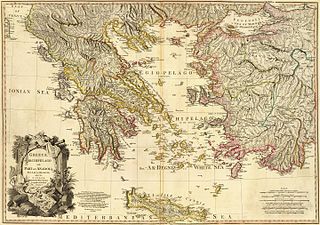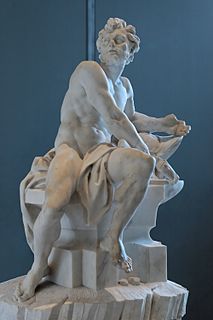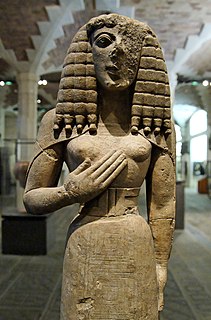
Athena or Athene, often given the epithet Pallas, is an ancient Greek goddess associated with wisdom, warfare, and handicraft who was later syncretized with the Roman goddess Minerva. Athena was regarded as the patron and protectress of various cities across Greece, particularly the city of Athens, from which she most likely received her name. The Parthenon on the Acropolis of Athens is dedicated to her. Her major symbols include owls, olive trees, snakes, and the Gorgoneion. In art, she is generally depicted wearing a helmet and holding a spear.

The Achaeans is one of the names in Homer which is used to refer to the Greeks collectively.

Ares is the Greek god of war and courage. He is one of the Twelve Olympians, and the son of Zeus and Hera. The Greeks were ambivalent toward him. He embodies the physical valor necessary for success in war but can also personify sheer brutality and bloodlust, in contrast to his sister, the armored Athena, whose martial functions include military strategy and generalship. An association with Ares endows places, objects, and other deities with a savage, dangerous, or militarized quality.

The Dorians were one of the four major ethnic groups into which the Hellenes of Classical Greece divided themselves. They are almost always referred to as just "the Dorians", as they are called in the earliest literary mention of them in the Odyssey, where they already can be found inhabiting the island of Crete.

Hephaestus is the Greek god of blacksmiths, metalworking, carpenters, craftsmen, artisans, sculptors, metallurgy, fire, and volcanoes. Hephaestus's Roman counterpart is Vulcan. In Greek mythology, Hephaestus was either the son of Zeus and Hera or he was Hera's parthenogenous child. He was cast off Mount Olympus by his mother Hera because of his lameness, the result of a congenital impairment; or in another account, by Zeus for protecting Hera from his advances.

Poseidon was one of the Twelve Olympians in ancient Greek religion and myth, god of the sea, storms, earthquakes and horses. In pre-Olympian Bronze Age Greece, he was venerated as a chief deity at Pylos and Thebes. He also had the cult title "earth shaker". In the myths of isolated Arcadia he is related with Demeter and Persephone and he was venerated as a horse, however it seems that he was originally a god of the waters. He is often regarded as the tamer or father of horses, and with a strike of his trident, he created springs which are related to the word horse. His Roman equivalent is Neptune.

In ancient Greek religion and mythology, Hestia is the virgin goddess of the hearth, the right ordering of domesticity, the family, the home, and the state. In myth, she is the firstborn child of the Titans Cronus and Rhea.
A paean is a song or lyric poem expressing triumph or thanksgiving. In classical antiquity, it is usually performed by a chorus, but some examples seem intended for an individual voice (monody). It comes from the Greek παιάν, "song of triumph, any solemn song or chant". "Paeon" was also the name of a divine physician and an epithet ("byname") of Apollo.

Eileithyia or Ilithyiae or Ilithyia was the Greek goddess of childbirth and midwifery, and the daughter of Zeus and Hera. In the cave of Amnisos (Crete) she was related with the annual birth of the divine child, and her cult is connected with Enesidaon, who was the chthonic aspect of the god Poseidon. It is possible that her cult is related with the cult of Eleusis. In his Seventh Nemean Ode, Pindar refers to her as the maid to or seated beside the Moirai (Fates) and responsible for the creation of offspring. Her son was Sosipolis, who was worshiped at Elis.
Enyo is a goddess of war in Greek mythology. She frequently is associated with the war god Ares.

Phobos is the god and personification of fear and panic in Greek mythology. Phobos was the son of Ares and Aphrodite, and the brother of Deimos. He does not have a major role in mythology outside of being his father's attendant.

Mycenaean Greece was the last phase of the Bronze Age in Ancient Greece, spanning the period from approximately 1750 to 1050 BC. It represents the first advanced and distinctively Greek civilization in mainland Greece with its palatial states, urban organization, works of art, and writing system. The Mycenaeans were mainland Greek peoples who were likely stimulated by their contact with insular Minoan Crete and other Mediterranean cultures to develop a more sophisticated sociopolitical culture of their own. The most prominent site was Mycenae, after which the culture of this era is named. Other centers of power that emerged included Pylos, Tiryns, Midea in the Peloponnese, Orchomenos, Thebes, Athens in Central Greece and Iolcos in Thessaly. Mycenaean settlements also appeared in Epirus, Macedonia, on islands in the Aegean Sea, on the south-west coast of Asia Minor, Cyprus, while Mycenaean-influenced settlements appeared in the Levant, and Italy.
In Greek mythology, two sacred mountains are called Mount Ida, the "Mountain of the Goddess": Mount Ida in Crete, and Mount Ida in the ancient Troad region of western Anatolia, which was also known as the Phrygian Ida in classical antiquity and is mentioned in the Iliad of Homer and the Aeneid of Virgil. Both are associated with the mother goddess in the deepest layers of pre-Greek myth, in that Mount Ida in Anatolia was sacred to Cybele, who is sometimes called Mater Idaea, while Rhea, often identified with Cybele, put the infant Zeus to nurse with Amaltheia at Mount Ida in Crete. Thereafter, his birthplace was sacred to Zeus, the king and father of Greek gods and goddesses.

Potnia is an Ancient Greek word for "Mistress, Lady" and a title of a goddess. The word was inherited by Classical Greek from Mycenean Greek with the same meaning and it was applied to several goddesses. A similar word is the title Despoina, "the mistress", which was given to the nameless chthonic goddess of the mysteries of Arcadian cult. She was later conflated with Kore (Persephone), "the maiden", the goddess of the Eleusinian Mysteries, in a life-death rebirth cycle which leads the neophyte from death into life and immortality. Karl Kerenyi identifies Kore with the nameless "Mistress of the labyrinth", who probably presided over the palace of Knossos in Minoan Crete.

In Greek mythology, Despoina was the daughter of Demeter and Poseidon and sister of Arion.
In Greek mythology, Paean, Paeëon or Paieon (Παιήων), or Paeon or Paion (Παιών) was the physician of the gods.
The religious element is difficult to identify in Mycenaean Greece, especially as regards archaeological sites, where it remains very problematic to pick out a place of worship with certainty. John Chadwick points out that at least six centuries lie between the earliest presence of Proto-Greek speakers in Hellas and the earliest inscriptions in the Mycenaean script known as Linear B, during which concepts and practices will have fused with indigenous Pre-Greek beliefs, and—if cultural influences in material culture reflect influences in religious beliefs—with Minoan religion. As for these texts, the few lists of offerings that give names of gods as recipients of goods reveal nothing about religious practices, and there is no other surviving literature.
Aphrodite Areia or "Aphrodite the Warlike" was a cult epithet of the Greek goddess Aphrodite, in which she was depicted in full armor like the war god Ares. This representation was found in Sparta and Taras. There were other, similarly martial interpretations of the goddess, such as at her Sanctuary at Kythira, where she was worshiped under the epithet Aphrodite Urania, who was also represented as being armed. The epithet "Areia", meaning "warlike", was applied to other gods in addition to Aphrodite, such as Athena, Zeus, and possibly Hermes.